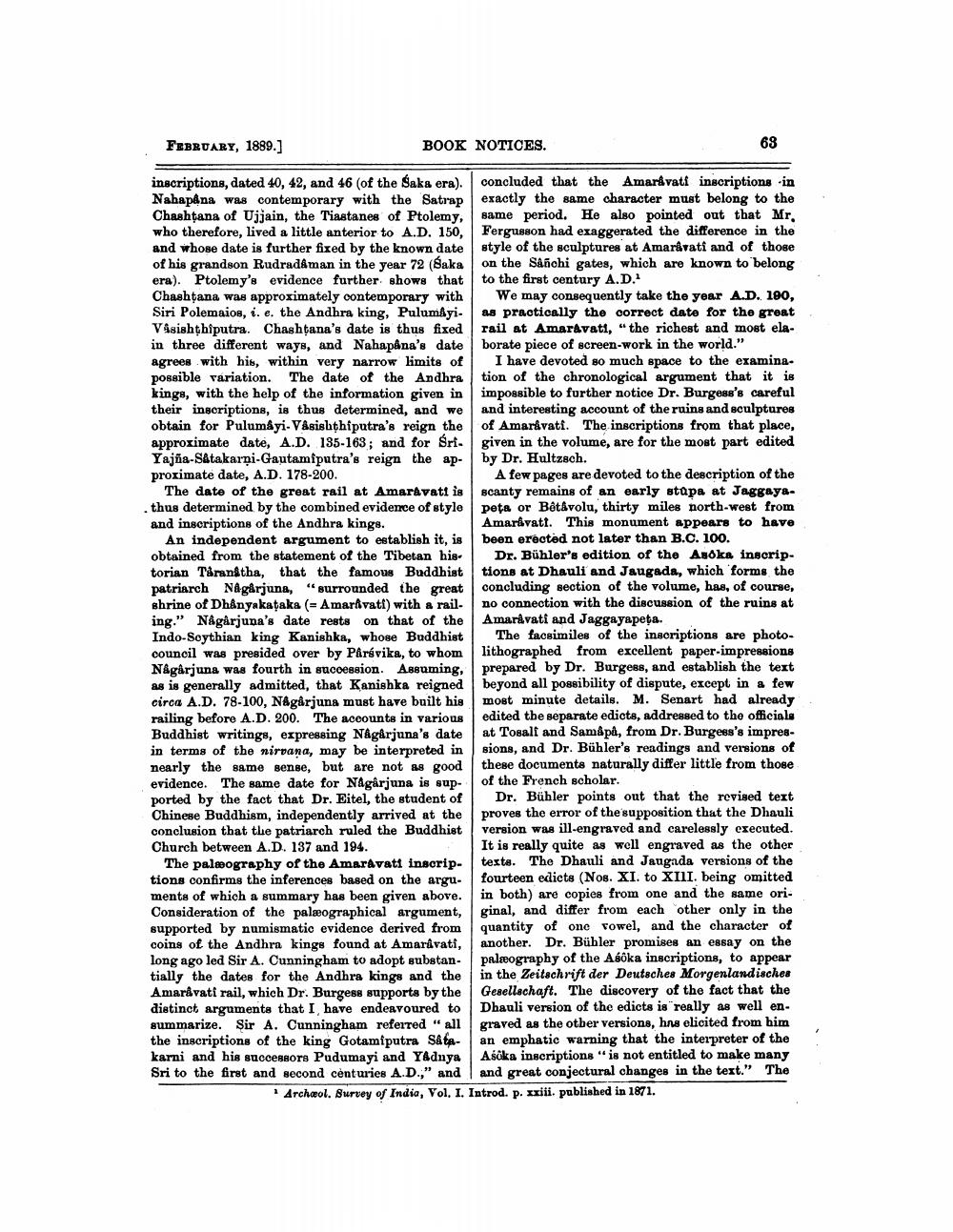________________
FEBRUARY, 1889.]
BOOK NOTICES.
68
inscriptions, dated 40, 42, and 46 (of the Saka era). concluded that the Amaravati inscriptions in Nahapana was contemporary with the Satrap exactly the same character must belong to the Chashtana of Ujjain, the Tiastanes of Ptolemy, same period. He also pointed out that Mr. who therefore, lived a little anterior to A.D. 150, Fergusson had exaggerated the difference in the and whose date is further fixed by the known date style of the sculptures at Amarárati and of those of his grandson Rudradêman in the year 72 (Saka on the Sanchi gates, which are known to belong era). Ptolemy's evidence further shows that to the first century A.D. Chashtana was approximately contemporary with We may consequently take the year A.D. 190, Siri Polemaios, i.e. the Andhra king, Pulumiyi. as practically the correct date for the great Vásishthiputra. Chashtana's date is thus fixed rail at Amaravati, "the richest and most elain three different ways, and Nahapâna's date borate piece of screen-work in the world." agrees with his, within very narrow limits of I have devoted so much space to the examinapossible variation. The date of the Andhration of the chronological argument that it is kings, with the help of the information given in impossible to further notice Dr. Burgess's careful their inscriptions, is thus determined, and we and interesting account of the ruins and sculptures obtain for Pulumâyi-Våsishthiputra's reign the of Amaravati. The inscriptions from that place, approximate date, A.D. 135-163; and for Śrt. given in the volume, are for the most part edited Yajia-Satakarni-Gautamiputra's reign the ap- by Dr. Hultzsch. proximate date, A.D. 178-200.
A few pages are devoted to the description of the The date of the great rail at Amaravatt is scanty remains of an early stupa at Jaggaya.thus determined by the combined eviderrce of style peta or Bêt&volu, thirty miles north-west from and inscriptions of the Andhra kings.
Amar vatt. This monument appears to have An independent argument to establish it, is been erécted not later than B.C. 100. obtained from the statement of the Tibetan his Dr. Bühler's edition of the Asoka inscriptorian Tåranátha, that the famous Buddhist tions at Dhauli and Jaugada, which forms the patriarch Nagarjuna, "surrounded the great concluding section of the volume, has, of course, shrine of Dhanya kataka (Amaravatt) with a rail no connection with the discussion of the ruins at ing." Nagarjuna's date rests on that of the Amaravati and Jaggayapeta. Indo-Soythian king Kanishka, whose Buddhist The facsimiles of the inscriptions are photocouncil was presided over by Parávika, to whom lithographed from excellent paper-impressions Nagarjuna was fourth in succession. Assuming, prepared by Dr. Burgess, and establish the text as is generally admitted, that Kanishka reigned beyond all possibility of dispute, except in a few circa A.D. 78-100, Nagarjuna must have built his most minute details. M. Senart had already railing before A.D. 200. The accounts in various edited the separate edicte, addressed to the officials Buddhist writings, expressing Nagarjuna's date at Tosalt and Sam&på, from Dr. Burgess's impresin terms of the nirvana, may be interpreted in
sions, and Dr. Bühler's readings and versions of nearly the same sense, but are not as good these documents naturally differ little from those evidence. The same date for Nagarjuna is sup- of the French scholar. ported by the fact that Dr. Eitel, the student of Dr. Bühler points out that the revised text Chinese Buddhism, independently arrived at the proves the error of the supposition that the Dhauli conclusion that the patriarch ruled the Buddhist version was ill-engraved and carelessly executed. Church between A.D. 137 and 194.
It is really quite as well engraved as the other The palæography of the Amaravati inscrip- tests. The Dhauli and Jaugada versions of the tions confirms the inferences based on the argu- fourteen edicts (Nos. XI. to XIII. being omitted ments of which a summary has been given above. in both) are copies from one and the same oriConsideration of the palæographical argument, ginal, and differ from each other only in the supported by numismatic evidence derived from quantity of one vowel, and the character of coins of the Andhra kings found at Amaravati, another. Dr. Bühler promises an essay on the long ago led Sir A. Cunningham to adopt substan- palmography of the Asöka inscriptions, to appear tially the dates for the Andhra kings and the in the Zeitschrift der Deutsches Morgenlandisches Amaravati rail, which Dr. Burgess supports by the Gesellschaft. The discovery of the fact that the distinct arguments that I have endeavoured to Dhauli version of the edicts is really as well ensummarize. Şir A. Cunningham referred "all graved as the other versions, hns elicited from him the inscriptions of the king Gotamiputra Sata- | an emphatic warning that the interpreter of the karni and his successors Pudumayi and Yadnya Asöka inscriptions " is not entitled to make many Sri to the first and second centuries A.D.," and and great conjectural changes in the text." The
Archæol. Burvey of India, Vol. 1. Introd. p. xxii, published in 1871.




